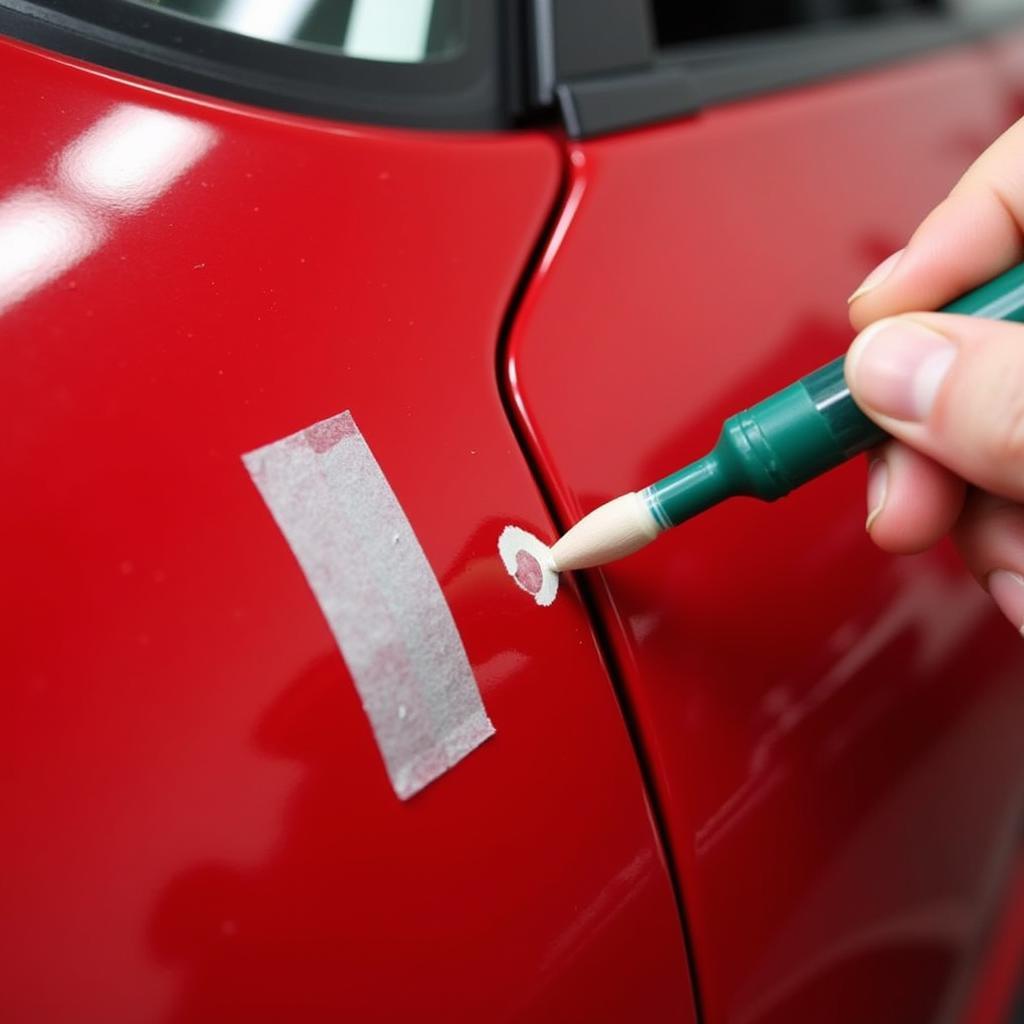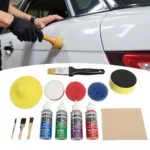Dealing with a paint chip in your car can be frustrating. Whether it’s a small nick from a stray rock or a larger scrape from a parking lot mishap, repairing paint chips is crucial to prevent rust and maintain your car’s appearance. This guide offers expert advice on how to effectively repair paint chip in car, covering everything from DIY solutions to professional repairs.
Understanding the Importance of Paint Chip Repair
Ignoring a seemingly minor paint chip can lead to significant problems down the road. Exposed metal is vulnerable to rust, which can spread quickly and compromise the structural integrity of your car. Addressing paint chips promptly not only preserves your car’s aesthetic appeal but also protects its value and longevity. Besides the obvious cosmetic reasons, a small chip can quickly become a large problem if moisture gets underneath and starts to rust the metal.
You can find more information about dealing with chipped paint on your car at chipped paint on car repair.
Why is Prompt Repair Essential?
Rust is the primary reason why prompt repair is crucial. Once rust sets in, the repair process becomes more complex and costly. Early intervention with a simple touch-up can save you hundreds of dollars in the long run. It also prevents the chip from expanding due to weather conditions and road debris. Regularly washing and waxing your car helps protect the paint and makes it easier to spot any new chips.
DIY Paint Chip Repair: A Step-by-Step Guide
For minor paint chips, a DIY approach can be both effective and cost-efficient. Before starting, it’s important to clean the area thoroughly with soap and water, then dry it completely. This will ensure proper adhesion of the touch-up paint.
-
Gather Your Supplies: You’ll need touch-up paint (matched to your car’s color code), rubbing compound, polishing compound, primer (if the chip reaches the metal), fine-grit sandpaper, masking tape, and applicator tools (brush, pen, or spray).
-
Prepare the Area: Mask off the area around the chip with tape to protect the surrounding paint. If the chip has exposed bare metal, apply a thin coat of primer.
-
Apply the Touch-Up Paint: Carefully apply the touch-up paint to the chip, using thin layers to avoid runs or drips. Let each layer dry completely before applying the next.
-
Level the Surface: Once the paint is dry, use fine-grit sandpaper to gently level the repaired area with the surrounding paint.
-
Polish and Finish: Apply rubbing compound followed by polishing compound to blend the repair seamlessly and restore the shine.
Learn more detailed instructions on how to repair paint chips on your car: how to repair car paint chipping.
When to Seek Professional Repair
While DIY repairs are suitable for minor chips, larger or more complex damage requires professional attention. Deep scratches, chips that have penetrated multiple layers of paint, or extensive rust require the expertise of a qualified auto body shop. Attempting a DIY repair on significant damage can often worsen the problem.
If you’re unsure about tackling the repair yourself, check out resources like paint chip car repair near me to find professional assistance in your area.
Benefits of Professional Repair
Professional auto body shops have the tools, expertise, and experience to handle complex paint chip repairs. They can accurately match your car’s paint color, ensuring a seamless blend. They also have access to advanced techniques like paintless dent repair (PDR) for certain types of damage.
“A professional repair ensures a perfect color match and a flawless finish, preserving the value of your vehicle,” says John Smith, Lead Technician at AutoCare Solutions.
Preventing Paint Chips
Taking preventative measures can significantly reduce the risk of paint chips. Regularly waxing your car creates a protective barrier against minor scratches and chips. Parking in covered areas whenever possible helps shield your car from harsh weather elements and stray debris. Using a car cover also provides excellent protection against environmental factors that can damage your car’s paint.
Conclusion
Repairing paint chips in your car, whether through DIY methods or professional services, is essential for maintaining its appearance and preventing rust. Addressing chips promptly safeguards your investment and keeps your car looking its best. Choosing the right repair method depends on the severity of the damage, but acting quickly is key.
For specific advice on repairing chipped paint on your car, explore resources like [how to repair chipping paint on car](https://carrepairon.com/how to repair chipping paint on car/). Remember, addressing paint chips promptly not only enhances the aesthetics but also protects your car’s value for years to come.
FAQ
- How much does it cost to repair a paint chip? The cost varies depending on the size and location of the chip, as well as the repair method. DIY repairs can cost a few dollars, while professional repairs can range from $50 to several hundred dollars.
- Can I use nail polish to repair a paint chip? While nail polish might seem like a quick fix, it’s not recommended. It won’t match the car’s paint precisely and can damage the existing paintwork.
- How do I find my car’s paint code? The paint code is usually located on a sticker inside the driver’s side doorjamb, glove compartment, or under the hood. You can also find it in your owner’s manual.
- What is the best way to prevent paint chips? Regular waxing, parking in covered areas, and using a car cover are effective preventative measures.
- Can I repair a paint chip in the rain? No, it’s crucial to repair paint chips in a dry environment to ensure proper adhesion and prevent moisture from getting trapped underneath the paint.
- How long does touch-up paint take to dry? Drying time varies depending on the type of paint and environmental conditions, but it usually takes between 30 minutes to a few hours.
- How do I remove excess touch-up paint? Use a razor blade or fine-grit sandpaper to carefully remove excess dried paint, then polish the area to blend it in.
“Regularly inspecting your car for paint chips and addressing them promptly is the best way to maintain its pristine condition,” advises Maria Garcia, Automotive Expert and Consultant.
Need assistance with your car repair? Contact us via WhatsApp: +1(641)206-8880, or Email: [email protected]. Our customer support team is available 24/7 to help.



